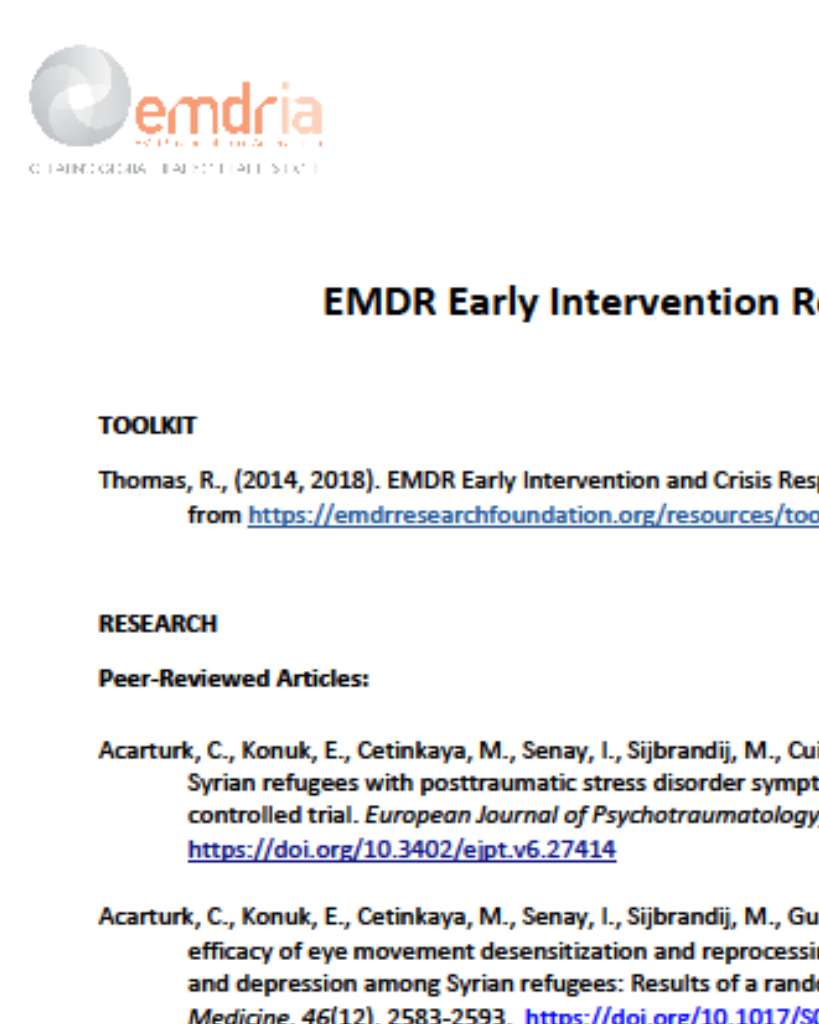Feasibility of eye movement desensitization and reprocessing in a person with dementia and post-traumatic stress disorder: A case report
This report aimed to provide a detailed description of the feasibility and challenges of EMDR for a person with dementia to assist in the first step toward recognizing and treating PTSD in people with dementia.
Article Abstract
“Introduction: Post-traumatic stress disorder (PTSD) is an independent risk factor for dementia. Case reports of poor-moderate quality indicate the feasibility of Eye Movement Desensitization and Reprocessing (EMDR) sessions in this population but lack a detailed description of the treatment and its challenges.
Goal: This report aimed to provide a detailed description of the feasibility and challenges of EMDR for a person with dementia to assist in the first step toward recognizing and treating PTSD in people with dementia.
Methods: In this case study, we describe an 89-year-old nursing home resident with mild–moderate dementia and trauma related symptoms. EMDR treatment was indicated, and four sessions, according to a standard child/youth protocol, were applied. Debriefing questionnaires were completed by a psychologist after each EMDR session. To monitor the effect of the EMDR therapy, a structured interview exploring PTSD symptoms (TRADE- TRAuma and DEmentia interview) was conducted between the treatment sessions.
Results: The debriefing questionnaires showed that EMDR was well tolerated and experienced as pleasant, but some challenges occurred; During the EMDR sessions she was easily distracted, requested multiple breaks, and required the use of shorter sentences, with a more directive approach. PTSD symptoms of recurring memories and negative thoughts were reduced.
Conclusions: This case report provides a detailed description showing the feasibility of EMDR therapy for a person with PTSD and dementia. It appeared necessary to adjust the EMDR standard child/youth protocol to a further simplified form, due to the reduced concentration and endurance.”
—Description from publisher
Article Access
Open Access
Ruisch, J. E., van Kordenoordt, M., Steins, C., Daamen, M. A. M. J., Schruers, K. R. J., Sobczak, S., & Gielkens, E. M. J. (2024). Feasibility of eye movement desensitization and reprocessing in a person with dementia and post-traumatic stress disorder: A case report. Psychiatry Research Case Reports, 3(2), 100239. https://doi.org/10.1016/j.psycr.2024.100239
Date
November 13, 2024
Creator(s)
J. E. Ruisch, M. van Kordenoordt, C. Steins
Contributor(s)
M. A. M. J. Daamen, K. R. J. Schruers, S. Sobczak, E. M. J. Gielkens
Topics
PTSD
Client Population
Older Adults
Extent
6 pages
Publisher
Elsevier B.V.
Rights
© 2024 The Author(s). This is an open access article under the CC BY-NC-ND license ( http://creativecommons.org/licenses/by- nc-nd/4.0/ ).
APA Citation
Ruisch, J. E., van Kordenoordt, M., Steins, C., Daamen, M. A. M. J., Schruers, K. R. J., Sobczak, S., & Gielkens, E. M. J. (2024). Feasibility of eye movement desensitization and reprocessing in a person with dementia and post-traumatic stress disorder: A case report. Psychiatry Research Case Reports, 3(2), 100239. https://doi.org/10.1016/j.psycr.2024.100239
Audience
EMDR Therapists
Language
English
Content Type
Article, Peer-Reviewed
Access Type
External Resource, Open Access





